
The House of Orange-Nassau is the current reigning house of the Netherlands. A branch of the European House of Nassau, the house has played a central role in the politics and government of the Netherlands and elsewhere in Europe, particularly since William the Silent organised the Dutch Revolt against Spanish rule, which after the Eighty Years' War (1568–1648) led to an independent Dutch state. William III of Orange led the resistance of the Netherlands and Europe to Louis XIV of France and orchestrated the Glorious Revolution in England that established parliamentary rule. Similarly, Queen Wilhelmina of the Netherlands was instrumental in the Dutch resistance during World War II.
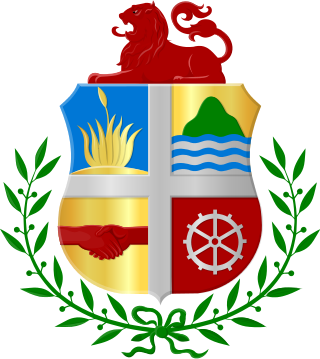
The Coat of arms of Aruba has been officially in use since November 15, 1955, as the recognized national symbol of Aruba.

The coat of arms of Toronto is a heraldic symbol used to represent the city Toronto. Designed by Robert Watt, the Chief Herald of Canada at the time, for the City of Toronto after its amalgamation in 1998. The arms were granted by the Canadian Heraldic Authority on 11 January 1999.

The coat of arms of Romania was adopted in the Romanian Parliament on 10 September 1992 as a representative coat of arms for Romania. The current coat of arms is based on the lesser coat of arms of interwar Kingdom of Romania, which was designed in 1921 by the Transylvanian Hungarian heraldist József Sebestyén from Cluj, at the request of King Ferdinand I of Romania, it was redesigned by Victor Dima. As a central element, it shows a golden aquila holding a cross in its beak, and a mace and a sword in its claws. It also consists of the three colors which represent the colors of the national flag. The coat of arms was augmented on 11 July 2016 to add a representation of the Steel Crown of Romania.

The coat of arms of the Kingdom of the Netherlands was originally adopted in 1815 and later modified in 1907. The arms are a composite of the arms of the former Dutch Republic and the arms of the House of Nassau, it features a checkered shield with a lion grasping a sword in one hand and a bundle of arrows in the other and is the heraldic symbol of the monarch and the country. The monarch uses a version of the arms with a mantle while the government of the Netherlands uses a smaller version without the mantle (cloak) or the pavilion, sometimes only the shield and crown are used. The components of the coats of arms were regulated by Queen Wilhelmina in a royal decree of 10 July 1907, affirmed by Queen Juliana in a royal decree of 23 April 1980.
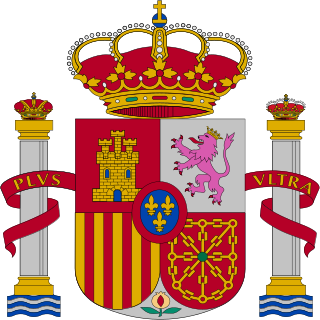
The coat of arms of Spain represents Spain and the Spanish nation, including its national sovereignty and the country's form of government, a constitutional monarchy. It appears on the flag of Spain and it is used by the Government of Spain, the Cortes Generales, the Constitutional Court, the Supreme Court, and other state institutions. Its design consists of the arms of the medieval kingdoms that would unite to form Spain in the 15th century, the Royal Crown, the arms of the House of Bourbon, the Pillars of Hercules and the Spanish national motto: Plus Ultra. The monarch, the heir to the throne and some institutions like the Senate, the Council of State and the General Council of the Judiciary have their own variants of the coat of arms; thus the state coat of arms is not an arms of dominion.

The coat of arms of Denmark has a lesser and a greater version.

The coat of arms of Portugal is the main heraldic insignia of Portugal. The present model was officially adopted on 30 June 1911, along with the present model of the Flag of Portugal. It is based on the coat of arms used by the Kingdom of Portugal since the Middle Ages. The coat of arms of Portugal is popularly referred as the Quinas.

The coat of arms of Gibraltar was first granted by a Royal Warrant passed in Toledo on 10 July 1502 by Isabella I of Castile during Gibraltar's Spanish period. The arms consists of an escutcheon and features a three-towered red castle under which hangs a golden key.

The coat of arms of Amsterdam is the official coat of arms symbol of the city of Amsterdam. It consists of a red shield and a black pale with three silver Saint Andrew's Crosses, the Imperial Crown of Austria, two golden lions, and the motto of Amsterdam. Several heraldic elements have their basis in the history of Amsterdam. The crosses and the crown can be found as decorations on different locations in the city.

The coat of arms of Bavaria has greater and lesser versions.

The Frisian flag is the official flag of the Dutch province of Friesland. The flag was officially adopted by the provincial executive of Friesland on 9 July 1957.

The coat of arms of Rotterdam is the official symbol of the city of Rotterdam. It consists of a shield and has a green band of the original weapon of Weena, bisected by a white band symbolizes the Rotte, two golden lions, and four lions, two black and two red on a gold field, and the motto of Rotterdam.
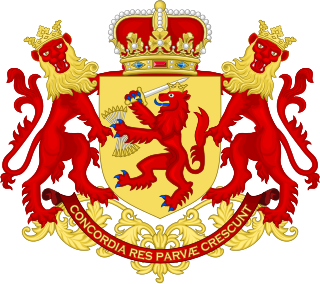
The Dutch Republic Lion was the badge of the Union of Utrecht, the Republic of the Seven United Netherlands, and a precursor of the current coat of arms of the Kingdom the Netherlands.

The coat of arms of The Hague is the official symbol of the city of The Hague.
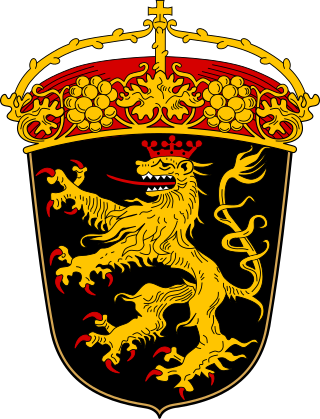
The Palatine Lion, less commonly the Palatinate Lion, is an heraldic charge. It was originally part of the family coat of arms of the House of Wittelsbach and is found today on many coats of arms of municipalities, counties and regions in South Germany and the Austrian Innviertel.

The coat of arms of Bellingwedde is an official symbol of the municipality of Bellingwedde in the province of Groningen in the Netherlands. It was officially adopted in 1969. The coat of arms consists of a crowned shield with blue, gold, and silver elements, which refer to the abbey Palmar and the Wedderborg. From 2018, the coat of arms is no longer in use as a municipal coat of arms because the municipality of Bellingwedde merged into the new municipality of Westerwolde.

The coat of arms of Enkhuizen has been the coat of arms ever since Enkhuizen received borough rights in 1355. The coat of arms was acknowledged in 1816 by the High Council of Nobility, the coat of arms has not been changed ever since.

The coat of arms that serves as the official symbol of the Masovian Voivodeship, Poland, consists of a red escutcheon, that features a white (silver) eagle, with raised wings, and its head turned left. Its current version had been designed by Andrzej Heidrich, and adopted in 2006.
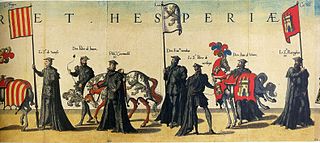
The first instance of a figure of the lion as symbol of the Kingdom of León is found in minted coins of Alfonso VII, called the Emperor (1126–1157). Until then, the cross had a preponderant position on documents and coins of Leonese monarchs since that reign the cross was gradually displaced by the lion. The Spanish historian and heraldist Martín de Riquer explained that the lion was already used as heraldic emblem in 1148. At the end of the reign of Alfonso VII, the figure of this animal began to appear on royal documents as personal device of the monarch and became pervasive during reigns of Ferdinand II (1157-1188) and Alfonso IX (1188-1230).






















